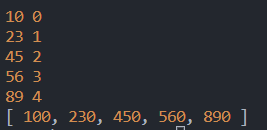JavaScript数组
解释说明
数组 : 数组对象是使用单独的变量名来存储一系列的值。
数组可以用一个变量名存储所有的值,并且可以用索引值访问数组中的任何一个值。
数组中的每个元素都有自己的的ID(索引值),以便它可以很容易地被访问到。
数组对象的属性
length : 数组的长度
声明数组的方式
数组中可以存放任何值 (存放任何数据类型的数据)
JS
// 1.字面量形式 使用更多的一种方式
var arr = [1,2,3,56,7];
var arr = ['hello','world','nihao'];
console.log(arr);
//[ 'hello', 'world', 'nihao' ]
// 2.二维数组
var arr1 = [1,2,[22,33,44]];
console.log(arr1);
//[ 1, 2, [ 22, 33, 44 ] ]
// 使用new关键字
var arr2 = new Array(10,20,30,40);
console.log(arr2);
//[ 10, 20, 30, 40 ]
// 访问数组中的值 通过索引值访问数组中的每一个值,索引值从 0 开始
var arr2 =[1,2,3,56,7];
console.log(arr2[3]);// 56
// 声明数字的另一种方式
var arr3 = new Array();
// 手动往数组中添加值
arr3[0] = 100;
arr3[1] = 200;
console.log(arr3);//[ 100, 200 ]
遍历数组(迭代数组)
JS
var arr = ['hello', 'world', 'nice'];
// 打印数组中的每个值 遍历数组
// 获取数组的长度 length 属性
console.log(arr.length);// 3
for (let i = 0; i < arr.length; i++) {
console.log(arr[i]);
//hello world nice
}JS
var str = 'hello';
// 修改变量的值 : 本质是给变量重新赋值
str = 'world';
console.log(str);//world
// 修改数组中的值
arr[1] = '新的值';
console.log(arr);//[ 'hello', '新的值', 'nice' ]
数组中的方法
🟢拼接检索
concat( )
说明:拼接数组,得到的结果是拼接后的新数组,对原数组不影响
JS
let arr3 = [1, 23, 345, 55, 1, 55, 99],
arr4 = ['hello', 'world'];
// 可以拼接多个数组,多个数组之间使用逗号隔开
let index3 = arr3.concat(arr4,arr4);
console.log(index3);
// [ 1, 23, 345, 55, 1, 55, 99, 'hello', 'world' , 'hello', 'world']
// es6提供的结构
let index4 = [...arr3, ...arr4]
console.log(index4);
//[ 1, 23, 345, 55, 1, 55, 99, 'hello', 'world' ]
indexOf( )
说明:检索指定的值在数组中第一次出现位置的索引值, 返回结果是索引值,不存在则返回-1
JS
let arr1 = [1, 23, 345, 55, 1, 55, 99];
let index1 = arr1.indexOf(55);
console.log(index1); // 3
lastIndexOf( )
说明:检索指定的值在数组中最后一次出现位置的索引值, 返回结果是索引值,不存在则返回-1
JS
let arr2 = [1, 23, 345, 55, 1, 55, 99];
let index2 = arr2.lastIndexOf(55);
console.log(index2);// 5
join( )
说明:拼接数组转换为字符串;
JS
// 使用指定的字符串拼接数组中的每个值,结果是字符串
let arr5 = [1, 23, 345, 55, 1, 55, 99],
arr6 = ['hello', 'world'];
let index5 = arr5.join('');
console.log(index5);// 1233455515599
let index6 = arr5.join('=');
console.log(index6);//1=23=345=55=1=55=99
console.log(typeof index6,index6);//string 1=23=345=55=1=55=99
toString( )
说明:直接数组转换为字符串类型
JS
let arr7 = [1, 23, 345, 55, 1, 55, 99];
let index7 = arr7.toString();
console.log(typeof index7,index7);
//string 1,23,345,55,1,55,99
🟢数组中添加或删除值
push( )
说明:往数组的最后边添加值, 返回值是新数组的长度 ; 改变的是原数组
JS
// 声明一个数组
var arr = ['hello', 'good', 22, 33, 44, 'world', 'nice'];
// ============== 数组中添加值 push(value) unshift(value)
arr.push(100);
// 返回值是新数组的长度
let len1 = arr.push();
console.log(len1); // 8
// 查看新数组的值
console.log(arr) ;
//['hello', 'good', 22, 33, 44, 'world', 'nice',100]
unshift( )
说明: unshift() 往数组的最前边添加值, 返回值是新数组的长度 ; 改变的是原数组
JS
var arr2 = ['hello', 'good', 22, 33, 44, 'world', 'nice'];
arr2.unshift('world');
let len2 = arr2.unshift('nice');
console.log(len2);// 9
console.log(arr2);
// ['nice','hello', 'good', 22, 33, 44, 'world', 'nice']
pop( )
说明:pop() 删除数组中的最后一个元素
JS
var arr3 = ['hello', 'good', 22, 33, 44, 'world', 'nice'];
// 返回值是被删除的元素
let len3 = arr3.pop();
console.log(len3);//nice
//输出删除后的数组
console.log(arr3);
//[ 'hello', 'good', 22, 33, 44, 'world' ]
shift( )
说明: shift() 删除数组中的第一个元素
JS
var arr4 = ['hello', 'good', 22, 33, 44, 'world', 'nice'];
// 返回值是被删除的元素
let len4 = arr4.shift();
console.log(len4);//hello
//输出删除后的数组
console.log(arr4);
// [ 'good', 22, 33, 44, 'world', 'nice' ]
🟢数组中其他方法
reverse( )
说明:反转数组; 对原数组进行改变, 返回值是改变后的原数组
JS
let arr = [10, 20, 30, 40, 50];
let res = arr.reverse();
console.log(res);//[ 50, 40, 30, 20, 10 ]
console.log(arr);//[ 50, 40, 30, 20, 10 ]
slice( )
说明:slice(startIndex, endIndex) 分割数组 截取的数组包前不包后
对原数组没有影响, 不会改变原数组, 返回值是截取的新数组
JS
//截取数组: 从指定的索引值位置开始,到指定的索引值位置结束,截取数组
let arr1 = [10, 20, 30, 40, 50];
let res1 = arr1.slice(1,2);
console.log(res1);//[ 20 ]
//截取数组: 从指定的索引值位置开始向后截取整个数组
let res2 = arr1.slice(1);
console.log(res2);//[ 20, 30, 40, 50 ]
console.log(arr1);//[ 10, 20, 30, 40, 50 ]
splice( )
说明:splice(startIndex, length, value) 加删除替换数组中的值; 返回值是被删除的数组中的元素 对原数组进行的更改(改变原数组)
JS
// 一个参数: 意味着从执行删除操作;从指定的起点索引值位置开始向后删除整个数组
let arr2 = [10, 20, 30, 40, 50];
let res3 = arr2.splice(1);
console.log(res3);//[ 20, 30, 40, 50 ]
// 两个参数: 执行删除的操作; 从指定的索引值位置开始删除指定长度的数组
let arr3 = [10, 20, 30, 40, 50];
let res4 = arr3.splice(1,2);
console.log(res4);//[ 20, 30 ]
console.log(arr3);//[ 10, 40, 50 ]
// 三个参数: 指定删除替换的操作;
// 从指定的索引值位置开始删除指定长度的数组,在原位置上(index)替换为新的值
let arr4 = [10, 20, 30, 40, 50];
let res5 = arr4.splice(1,1,'hello');
console.log(res5);//[ 20 ]
console.log(arr4);//[ 10, 'hello', 30, 40, 50 ]
sort( )
说明:对数组进行排序 , 需要指定参数, 参数是一个函数
JS
let arr6 = [1, 20, 12, 2, 35, 11, 100, 56];
// 对数组进行排序, 改变原数组
// 没有指定参数,简单的按照位上数字大小进行排序
arr6.sort();
console.log(arr6);
// [1, 100, 11, 12, 2, 20, 35, 56]JS
// 指定参数,实现真正的排序(升序)
arr6.sort(function(x,y){
// 升序
return x - y;
});
console.log(arr6);
//[1, 20, 12, 2, 35, 11, 100, 56]JS
// 指定参数,实现真正的排序(降序)
arr6.sort(function(x,y){
// 升序
return y - x;
});
console.log(arr6);
//[100, 56, 35, 20, 12, 11, 2, 1]
includes( )
说明:判断数组中是否存在指定的值 ,结果是布尔值,true:存在, false: 不存在
JS
let arr7 = [1, 20, 12, 2, 35, 11, 100, 56];
let res7 = arr.includes(20);
let res8 = arr.includes(200);
console.log(res7);//true
console.log(res8);//false
🟢ES6往后新增的方法
reduce( )
entries( )
every( )
fill( )
filter( )
find( )
findIndex( )
findLast( )
findLastIndex( )
keys( )
map( ) 遍历数组
说明:返回值是一个新数组; 执行的操作是把原数组中的每个值按照指定的规则映射到新数组中
JS
let newArr = arr.map(function(item,index){
// item 代表数组中的每个值, index 代表数组的索引值
console.log(item,index);
// 指定映射规则,通过return返回映射后的值
return item * 10;
})
console.log(newArr);

some( )
判断是否为数组的方法
console.log(obj instanceOf Array) > true/fales
console.log (arrAy.isArray(obj)) > true/fales





【推荐】国内首个AI IDE,深度理解中文开发场景,立即下载体验Trae
【推荐】编程新体验,更懂你的AI,立即体验豆包MarsCode编程助手
【推荐】抖音旗下AI助手豆包,你的智能百科全书,全免费不限次数
【推荐】轻量又高性能的 SSH 工具 IShell:AI 加持,快人一步
· 被坑几百块钱后,我竟然真的恢复了删除的微信聊天记录!
· 没有Manus邀请码?试试免邀请码的MGX或者开源的OpenManus吧
· 【自荐】一款简洁、开源的在线白板工具 Drawnix
· 园子的第一款AI主题卫衣上架——"HELLO! HOW CAN I ASSIST YOU TODAY
· Docker 太简单,K8s 太复杂?w7panel 让容器管理更轻松!